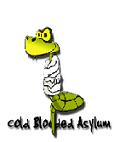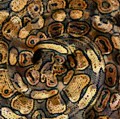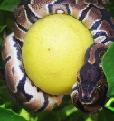» Site Navigation

2 members and 960 guests
Most users ever online was 47,180, 07-16-2025 at 05:30 PM.
» Today's Birthdays

» Stats

Members: 75,928
Threads: 249,128
Posts: 2,572,274
Top Poster: JLC (31,651)
|
-
Registered User

Help Desperately Needed
hello all! i havent posted but once or twice, but need some help and thought you guys were my best bet. let me tell you a story...
back in the middle of september, i bought a 1 month old orange granite female bp. the night we brought her home, she took down 2 live hoppers without an issue. from that night forward, once a week she took down 1-3 live hoppers, depending on their size, for quite a few weeks. then one week, i tried her on a smaller adult sized mouse. although she took it down, she took awhile to get it down. since that night (about 6 weeks ago), she has not shown any interest in food. a month ago she was down to 69 grams, and is now down to 57 grams. she has been to the vet, who did a tube feeding and said to keep trying on small prey (pinkies, etc), but she has shown no interest at all in food, and is starting to waste away. she will be returning to the vet very soon for possible blood tests (fecals are impossible because there is nothing in her to get anything out of according to the vet), but im hoping for some ideas.
ok, the basics on her care
small tub setup, temps 90-92 with the basic gradient using human heat pad, 2 small tight hides (one on each side).
feeding attempts have been both f/t and live mice and rats (hoppers or fuzzies), and one live pinkie (left in over night per the vet). we have tried feeding both in the tub and in a different enclosure. no luck with anything, she just either sniffs and runs or balls up completely and hides her head as far as she can.
the biggest oddball situation is the lump that formed, went away, and now is back. of course it went away RIGHT before going to the vet, so he did not see it, but it has come back. there is NOTHING in her system according to the vet, so im thinking an infection or something? it is right above her vent, and is about 1/2" long.
here are a bunch of pics. yes, i know how skinny she is, but she was much bigger 6 weeks ago when she was eating. you can see the bump in several pics. if anyone has ANY ideas, please let me know. obviously she is going back to the vet, but im hoping for some ideas we can give to him, because he seems a little stumped too, and he is one of the best in the state. thanks for the help up front! here are the pics that were taken tonight.











-
-
BPnet Veteran


Re: Help Desperately Needed
when ever people have trouble feeding i always advise to prescent the room it seems to get their mouths watering for food. heres a good link
http://www.ball-pythons.net/modules....warticle&id=60
 Cold Blooded Asylum Cold Blooded Asylum- COMING SOON to a Rack Near You
-
-
Re: Help Desperately Needed
Just tossing out ideas, but there is a condition from hatching about the yolk being retained. It turns into a hard spot. It doesn't fit well.... but....
She could be impacted? Maybe the pee builds up at the impact site, then seeps past slowly, thereby making the lump disappear?
Otherwise, I'd have to say the vet will have to make some guesses too.
All my guesses are ONLY guesses, and I just want to help. Maybe get a african rat fuzzy to try to tempt her?
Good luck I hope she starts eating and recovers!
Wolfy
-
-
Registered User


Re: Help Desperately Needed
that lump definately looks like something needs to pass and is not, has your vet done an x-ray to make sure there is nothing blocking?
Just an idea
 Now that I'm hooked, who's gonna buy me shoes???
1.1 Ball Python "Normal" (Columbus and Pocahontas)
1.1 Ball Python "100% Het Albino" (Baby) (on the way)
1.0 Ball Python "DH Snow Joliff / Albino" (on the way)
0.1 Black Long Haired Cat (Sheba 4)
0.2 Austrailian Shepherds (Dixie 17, Jesse 1)
2.2 Rats (Frank, George, Mocha and Latte) Now that I'm hooked, who's gonna buy me shoes???
1.1 Ball Python "Normal" (Columbus and Pocahontas)
1.1 Ball Python "100% Het Albino" (Baby) (on the way)
1.0 Ball Python "DH Snow Joliff / Albino" (on the way)
0.1 Black Long Haired Cat (Sheba 4)
0.2 Austrailian Shepherds (Dixie 17, Jesse 1)
2.2 Rats (Frank, George, Mocha and Latte)
-
-
Re: Help Desperately Needed
Hi,
First thing is to show those pics to the vet - the more information they have the better they can help the animal. I only mention this in case in case you forget 
If its impaction or obstruction of the bowel then yes its very serious - we had a baby iguana die once because a human hair (long - and for some reason purple) had somehow got mixed in her food and then went all through her gut snagging at points along the way and causing blockages.
I'm not sure if soaking her in a very shallow dish of warm water would be of anmy help if there was a medical reason for the lump forming and to be honest would leave any treatment descisions to the vet.
Hopefully some of the larger breeders will have seen something similar and could give advice from direct experience.
I hope she gets better soon 
dr del
Derek
7 adult Royals (2.5), 1.0 COS Pastel, 1.0 Enchi, 1.1 Lesser platty Royal python, 1.1 Black pastel Royal python, 0.1 Blue eyed leucistic ( Super lesser), 0.1 Piebald Royal python, 1.0 Sinaloan milk snake 1.0 crested gecko and 1 bad case of ETS. no wife, no surprise.
-
-
Registered User

Re: Help Desperately Needed
thanks for all the replies so far guys! we are doing soaks a few times a week already, and trying to keep her a little warmer than normal most days. we have prescented the room. it all seemed to happen when the bigger mouse was fed. the vet didnt do any xrays, but did the flashlight test and said she has nothing in her to block her up. we did get an idea from a breeder friend - he said that something like what she is going through is usually a parasitic infestation, which is rare in cb animals, which means she COULD be wc. he suggested treating with some panacur and keeping her hydrated for the next 2 weeks, and keep trying to feed. hows this sound to you guys? at least its an idea, and at least panacur cant really hurt her, even if it doesnt help. i have treated many leopard geckos with it, and have that experience.
anyone else have any ideas? not that the ones you have given arent great, but the more i can give to the vet the better...
-
-
Registered User


Re: Help Desperately Needed
i dont know how to help you, but i really hope that all goes well. The ver should be able to help, and hopefully the lump stays long enough for him to see it.
and if it is any conselation, she is a beautiful girl, i hope she pulls through!!!
 ..:.*Amy*.:.. ..:.*Amy*.:..
1.0 2006 Columbian Red Tail Boa (Cypher)
Coming November 29th 2006 1.0 100% Het. Pied (Dakarai)
Coming November 30th 2006 0.1 Pied (Makeena)
0.1 2002 Pug X Shih Tzu (Shimona)
1.0 Thoroughbred Gelding (Jackson)
-
-
BPnet Veteran


Re: Help Desperately Needed
I agree that you should bring those pictures to the vet. if soaking isnt helping or anything else, then try it. It really looks bad..poor thing 
Let us know how she does.
I rack my husbands balls & show my rack on Ball-Pythons.net
~I make girls with balls look good~
Qiksilver "yes, watch your children, I'll convert them to satanism..."
-
-
Re: Help Desperately Needed
i noticed you don't mention what your cool side's temp is, or how you take the temps... so although i have no additional info other than what has already been offered to you... i thought i'd pull this info from our caresheets for ya: 
TEMPERATURE
~90F (warm side)
~80F (cool side)
75 or below is unhealthy
Maintaining proper temperatures is essential to keeping your ball python healthy – failure to do so can lead to a host of issues from poor feeding to potentially lethal respiratory infections. For this reason you want to make sure you are able to measure the temperatures accurately. The sticker-type label thermometers sometimes seen used on aquariums are not sufficient for measuring much more than the temperature of the surface they are stuck to and many of the dial-type analog thermometers available in pet stores are routinely inaccurate. Do yourself and your ball python a tremendous favor and invest in a digital thermometer – one of the most cost-effective and easily available is the Accu-Rite digital thermometer/hygrometer combo available at large stores such as Wal-Mart. These retail for appx $15 and include a probe making it possible to monitor the warm side and cool side temps as well as the humidity levels all simultaneously. You can also invest in a temp-gun for appx $25 which uses a beam to give you instant surface temperature readings (note – these cannot measure air or ambient temperature however).
HEAT SOURCES
Heating pads designed for human use have been used with great success by a large number of keepers – but it must be noted that you must obtain one which does not have the “auto-shutoff” feature or you will be unable to maintain your temperatures. These are usually available in large stores and pharmacies for appx $10 and the same caveats for UTH apply – make sure you have some clearance under your enclosure.
MONITOR YOUR TEMPERATURES – If the ambient room temperatures in your house fluctuate then likely the temperatures in your reptiles enclosures are as well. If you find it difficult to maintain your temperatures adequately you should invest in a thermostat to help regulate your temperatures and keep your reptiles healthy.
Heat lamps make decent supplemental heating sources but when using this approach be aware that light-based heat can contribute to the quicker evaporation of moisture in the air of your enclosure. Unsuitably dry conditions can leading to difficult sheds and other health issues. When using this method to supplement heat make sure visible light sources are not left on 24hrs – this constant light can cause great stress in these creatures. Non visible heat lamps (red or black bulbs) should be utilized if the source must be kept on overnight.
in light, Aleesha
 
You have 1440 minutes a day... how are you going to spend yours?
-
-
Re: Help Desperately Needed
i also noticed you didn't mention a water dish... do you have one?
in light, Aleesha
 
You have 1440 minutes a day... how are you going to spend yours?
-
 Posting Permissions
Posting Permissions
- You may not post new threads
- You may not post replies
- You may not post attachments
- You may not edit your posts
-
Forum Rules
|



















 Reply With Quote
Reply With Quote Cold Blooded Asylum-COMING SOON to a Rack Near You
Cold Blooded Asylum-COMING SOON to a Rack Near You
 Now that I'm hooked, who's gonna buy me shoes???
Now that I'm hooked, who's gonna buy me shoes???




